Galapagos Famous Animals
Located at the convergence of three ocean currents, the Galapagos Islands are home to numerous marine species. The archipelago also experiences constant volcanic and seismic activities, and therefore, happens to be one of the most visited travel destinations amongst the adventurous travelers. The islands of Galapagos and their surroundings form a national park, a biological marine reserve and an Ecuadorian province. Renowned for being home to a number of Galapagos famous animals and endemic species, the enchanted islands are ideal for nature lovers.
However, the constantly growing population and tourism industry poses a serious threat to the animals of the Galapagos Islands , as has been warned by many wildlife and marine experts.
There are a number of famous and exceptional species in the Galapagos Islands. Here is the description of five such species that you shouldn’t miss to catch a sight of while visiting:
The Galapagos Tortoises:
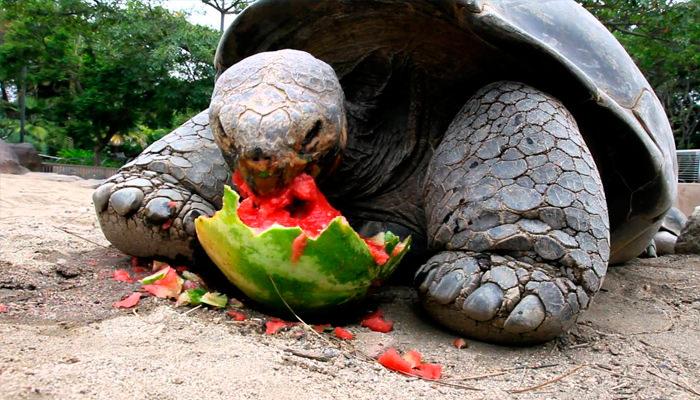
The Galapagos Tortoises are perhaps the Galapagos famous animal per se, considering they gave the name “Galapagos” to the archipelago and are one of the two giant tortoise species found in the world today. The word “galápago” meant saddle or tortoise in Spanish. Thus, the existence of these large tortoises gave this special name to the islands. These huge tortoises were found to weight about 400kg and were measured to be about 1.8 meters in length.
Many Galapagos Tortoises were found to live for more than a 100 years. The favorable climate that supported the life and growth of these tortoises has helped them exist on seven islands of the Galapagos Islands. The Galapagos tortoises are found to differ in the shape and size of their shell. The ones that are found in humid highlands are larger with domed shells and short necks. While the ones found on dry lowlands are smaller, with saddle shaped shells and long necks.
It was observed that the tortoise numbers declined drastically from the 16th century to the 17th century. This was caused mainly due to the exploitation of the species for meat5 and oil and the introduction of the other species in their habitat. Thus, efforts are still on to conserve this endangered species of Galapagos Tortoises that are found nowhere else in the world.
Lava Lizards:
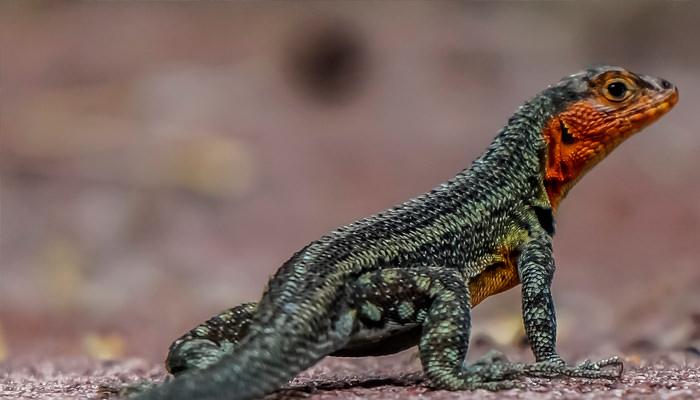
The lava lizards are usually 15 to 30 cm long. These are small reptiles with specific physical characteristics like tapering and long nails, pointed heads and slim bodies. They are often confused with geckos, but unlike geckos, lava lizards have pointed and long toes.
The adult male lava lizards have varied pattern of markings and colors on their body. Usually, these markings are adapted in order blend with the substrate on which they live. Most of the males are dark grey with black speckling. Once they are matured, they develop a black throat and a short crest of spiny scales. The males are two-three times heavier than their female counterparts. The adult female lava lizards are quite similar to the males in structure. But they are quite smaller and also lack the spiny scales along the back. Contrary to the males, they develop a red or orange throat once they are mature.
Talking about their behavior, both the males and the females challenge intruders by doing ‘push-ups’ using their front legs. While the males take a time of three years to be sexually matured, females can breed when they are just nine months old.
Galapagos Hawk:
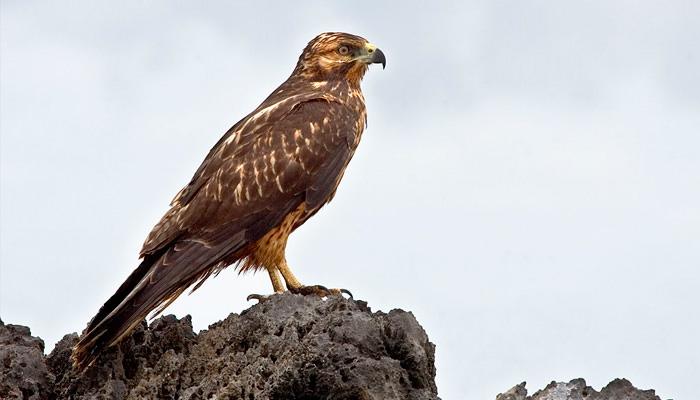
This is a large hawk that is endemic to the Galapagos Islands. It is the only raptor that breeds in these islands. They are usually 55 cm from beak to tail and have a wingspan of 120 cm. While the adult hawks have various coloring within the species, they are usually seen in a sooty brownish black color. The legs, feet and the ceres are yellow in color. Their wings are broader as compared to other seabirds. The feathers of the wings are barred with white and these are a little paler. The Galapagos Hawks have silvery grey tails, with around ten narrow black bars.
These hawks live largely on insects like centipedes, locusts, snakes, rodents and small lava lizards. They can also take young land or marine iguanas, as well as tortoise or sea turtle hatchlings. Their call, which is a series of short screams, is similar to that of the Red-shouldered Hawks.
There is no particular mating season for these hawks as they mate throughout the year. Though the male hawks tend to be monogamous, the females can mate with up to seven different males. Throughout the period of nesting, the female and all of her male companions protect and incubate the nests. The males also take part in feeding.
Hammerhead Sharks:
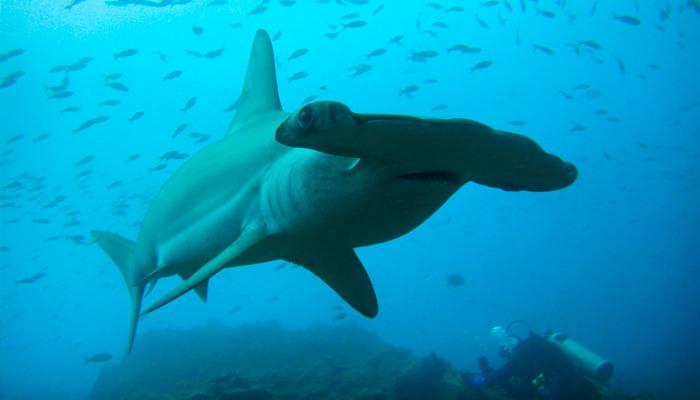
Hammerhead Sharks are a group of sharks, which utilize their oddly shaped heads to find prey. They are gifted with wide eyes, which allow them an improved visual range. They are usually 0.9 to 6 m long and weigh from 3 to 580 kg. Usually, they are light grey in color with a hint of green. They are gifted with white bellies, which allow them to blend in with the ocean and sneak up on their preys. Like all other sharks, Hammerheads too, have electroreceptory sensory pores, which are called ampullae of Lorenzini. These receptors allow the Hammerheads to sweep for prey more quickly and effectively.
Hammerhead Sharks live on a wide range of prey that includes squid, fish, octopus, other sharks and crustaceans. However, stingrays are their favorite. The Great Hammerhead Sharks, which are more aggressive than the usual ones, often end up eating other Hammerhead Sharks as well as their own babies.
Mating occurs only once a year among Hammerhead Sharks and that too, only when the male shark keeps on biting the female shark violently, until and unless she agrees to mate with him. The process of fertilization is internal and once the babies are born, the parents don’t take care of them. The baby sharks swim and huddle together until they are large and old enough to live on their own.
Galapagos Islands Marine Iguana:
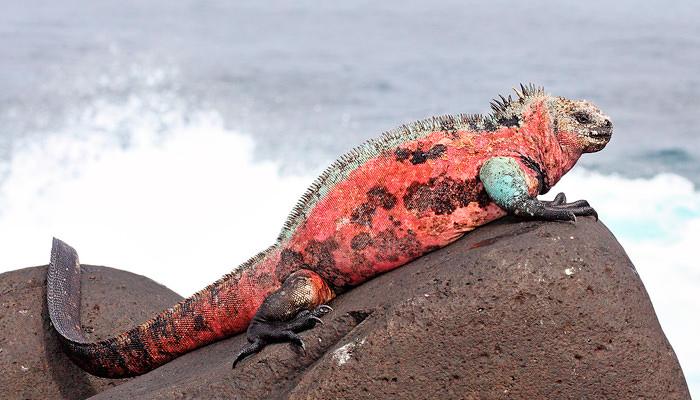
These are the marine iguanas which can be found only in the Galapagos Islands. Though they mainly live on the rocky shores, they can also be found at mangrove beaches and marshes. While it is true that they do sport a fierce look with their smashed-in faces, wide eyes, salt-encrusted and knotty heads and spiky dorsal scales, they are absolutely gentle herbivores.
Marine iguanas survive largely on seaweed and algae, which are found under the ocean. They are gifted with blunt, short snouts and razor-sharp teeth, which help them scrape the algae off the rocks easily. They can cling to rocks underwater in heavy currents and also on shores with their sharp and long claws. Their flattened tails help them swim like crocodiles. While hungry, marine iguanas become shorter as well as thinner too. After eating sufficiently, they re-grow. In fact, the adult iguanas can switch between shrinkage and growth time and again, throughout their lifetime. The bone absorption is the cause of reduction in their size and shape.
During the breeding season, the male iguanas defend the territories on land, where they mate with the females. The female iguanas keep their eggs in burrows, created by their male partners. The iguanas develop their colors as and when they mature. They are black during the young age, while the adults are red and black in color.

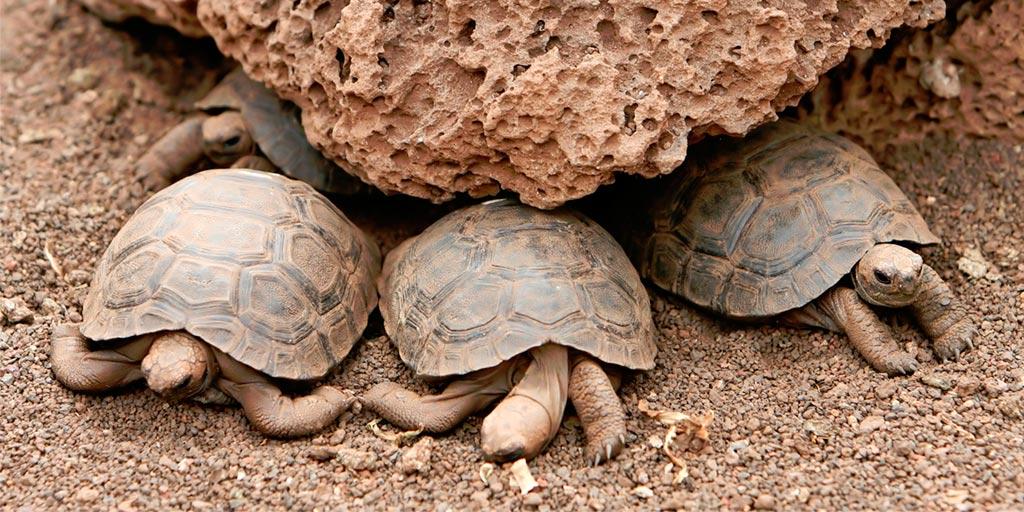

Comments